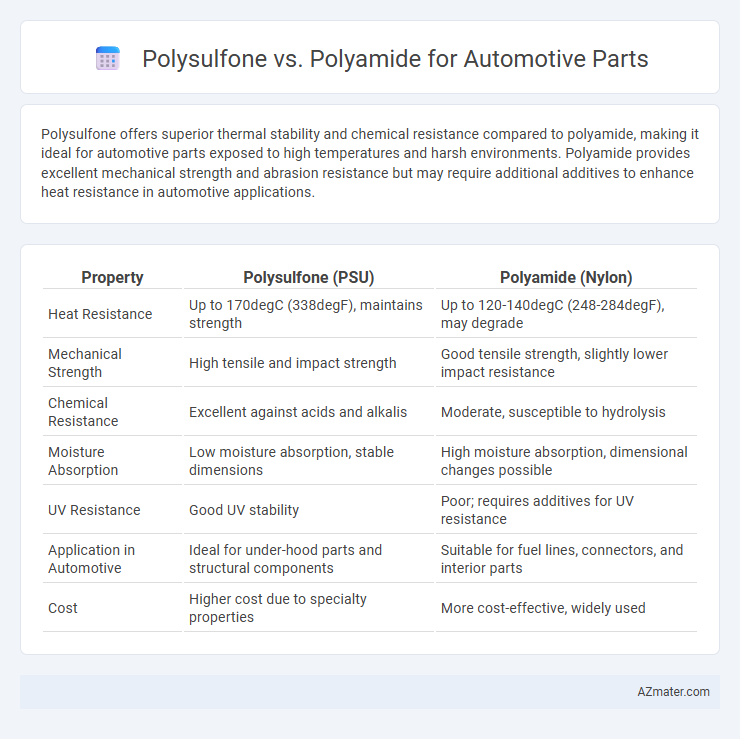Polysulfone offers superior thermal stability and chemical resistance compared to polyamide, making it ideal for automotive parts exposed to high temperatures and harsh environments. Polyamide provides excellent mechanical strength and abrasion resistance but may require additional additives to enhance heat resistance in automotive applications.
Table of Comparison
| Property | Polysulfone (PSU) | Polyamide (Nylon) |
|---|---|---|
| Heat Resistance | Up to 170degC (338degF), maintains strength | Up to 120-140degC (248-284degF), may degrade |
| Mechanical Strength | High tensile and impact strength | Good tensile strength, slightly lower impact resistance |
| Chemical Resistance | Excellent against acids and alkalis | Moderate, susceptible to hydrolysis |
| Moisture Absorption | Low moisture absorption, stable dimensions | High moisture absorption, dimensional changes possible |
| UV Resistance | Good UV stability | Poor; requires additives for UV resistance |
| Application in Automotive | Ideal for under-hood parts and structural components | Suitable for fuel lines, connectors, and interior parts |
| Cost | Higher cost due to specialty properties | More cost-effective, widely used |
Introduction to Polysulfone and Polyamide
Polysulfone (PSU) is a high-performance thermoplastic known for its excellent thermal stability, chemical resistance, and mechanical strength, making it suitable for demanding automotive applications such as fuel system components and electrical connectors. Polyamide, commonly known as nylon, offers superior wear resistance, toughness, and good mechanical properties, widely used for gears, bearings, and under-the-hood parts exposed to friction and high temperatures. Both polymers provide critical benefits in automotive part manufacturing, with polysulfone excelling in durability under harsh chemical environments and polyamide favored for its toughness and flexibility.
Key Properties of Polysulfone in Automotive Applications
Polysulfone (PSU) offers exceptional thermal stability with a continuous use temperature up to 150degC, making it ideal for under-the-hood automotive components exposed to high heat. Its excellent chemical resistance ensures durability against fuels, oils, and cleaning agents commonly encountered in automotive environments. The material's high impact strength and dimensional stability contribute to reliable performance in structural parts, outperforming polyamide (PA) in applications requiring sustained mechanical and thermal resilience.
Key Properties of Polyamide in Automotive Components
Polyamide exhibits exceptional mechanical strength, high impact resistance, and excellent thermal stability, making it ideal for demanding automotive components like fuel lines and engine covers. Its superior chemical resistance to oils, fuels, and coolants enhances durability under harsh operating conditions. Polyamide's lightweight nature contributes to overall vehicle efficiency by reducing weight without compromising structural integrity.
Comparative Mechanical Strength: Polysulfone vs Polyamide
Polysulfone exhibits higher tensile strength and superior impact resistance compared to polyamide, making it more suitable for automotive parts subjected to rigorous mechanical stress. Polyamide offers better flexibility and fatigue resistance but tends to absorb more moisture, which can reduce its mechanical performance over time. The thermal stability of polysulfone also surpasses that of polyamide, maintaining mechanical integrity under high-temperature conditions in automotive applications.
Chemical Resistance in Automotive Environments
Polysulfone exhibits superior chemical resistance compared to polyamide, particularly against hydrocarbons, oils, and automotive fluids, making it more suitable for demanding automotive applications. Polyamide tends to absorb moisture, which can degrade its chemical resistance and mechanical properties over time in harsh automotive environments. This inherent chemical stability of polysulfone ensures longer service life and enhanced durability for automotive parts exposed to aggressive chemicals.
Thermal Stability: Polysulfone vs Polyamide
Polysulfone exhibits superior thermal stability compared to polyamide, maintaining its mechanical properties at continuous use temperatures up to 150-180degC, whereas polyamide typically degrades above 120-130degC. This high thermal resistance makes polysulfone ideal for automotive parts exposed to elevated engine temperatures and harsh under-the-hood conditions. In contrast, polyamide's lower thermal threshold demands careful consideration in applications requiring prolonged heat exposure to avoid premature failure.
Processing and Manufacturing Differences
Polysulfone (PSU) offers high thermal stability and chemical resistance, making it suitable for high-temperature automotive parts, while polyamide (PA) provides excellent mechanical strength and wear resistance but is more sensitive to moisture absorption. PSU processing typically involves injection molding at higher temperatures around 320-360degC, requiring precise thermal control to maintain material integrity, whereas polyamide processes at lower temperatures of about 230-270degC with the need for pre-drying to reduce moisture-related defects. Manufacturing with polysulfone demands specialized equipment to handle its higher melting point and viscosity, whereas polyamide benefits from broader processing versatility and faster cycle times in conventional molding setups.
Cost Analysis for Automotive Parts
Polysulfone offers higher thermal stability and chemical resistance than polyamide, which often translates to longer lifespan but comes at a higher material cost, typically 20-30% more expensive. Polyamide, favored for its cost-effectiveness and excellent mechanical strength, reduces manufacturing expenses and is widely used in automotive parts like fuel lines and engine covers. Cost analysis shows polyamide as the economical choice for high-volume production, while polysulfone suits specialized applications requiring durability and heat resistance despite the increased investment.
Typical Automotive Applications: Polysulfone vs Polyamide
Polysulfone and polyamide are widely used in automotive parts due to their thermal stability and mechanical strength. Polysulfone excels in applications requiring high heat resistance and dimensional stability, such as under-the-hood components and electrical connectors. Polyamide is preferred for fuel system parts, engine covers, and structural components because of its excellent chemical resistance and toughness.
Conclusion: Choosing the Right Material for Automotive Parts
Polysulfone offers superior thermal stability and chemical resistance, making it ideal for under-the-hood automotive components exposed to high temperatures and harsh chemicals. Polyamide, known for its excellent mechanical strength and flexibility, suits structural parts requiring impact resistance and durability. Selecting the right material depends on specific application demands, balancing environmental exposure and mechanical performance for optimal automotive part longevity.

Infographic: Polysulfone vs Polyamide for Automotive Part
 azmater.com
azmater.com